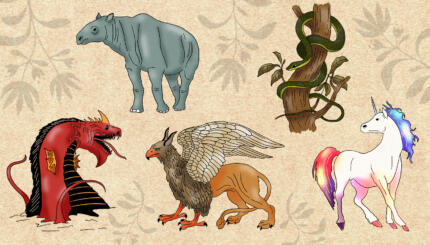The third and final section of the Hebrew Bible, Writings (Ketuvim), contains five scrolls called megillahs that are read in synagogue on different Jewish holidays. For obvious reasons, Esther is read on Purim — it both tells the Purim story and contains the commandment to celebrate Purim. Lamentations, likewise, is read on Tisha B’Av because it evokes the suffering of the Jews in the wake of the destruction of the Temple. There are less obvious reasons that Ruth is read on Shavuot and Ecclesiastes is read by some communities on Sukkot.
Perhaps the most elusive connection of all is the one between Song of Songs (Shir Hashirim in Hebrew) and Passover. Not all Jewish communities agree about exactly when during the holiday it is read. Ashkenzai communities usually read Song of Songs on the intermediate Shabbat of Passover while Sephardic communities tend to read it before the Mincha (afternoon) service on the eighth day of Passover (seventh day in the land of Israel). But Italian Jews read Song of Songs during the Maariv (evening) service on the first and second days of Passover, which closely aligns with a custom many different communities have of reading it in full at the conclusion of the seder. These differences aside, nearly every Jewish community in some way connects this biblical book to the holiday.
Song of Songs is an erotic poem, traditionally understood to symbolize the love between God and the Jewish people. Passover is a celebration of the freeing of the Israelites from Egyptian bondage. So what’s the deep connection between the two?
With your help, My Jewish Learning can provide endless opportunities for learning, connection and discovery.
Springtime and Pharaoh
The traditional explanation for this liturgical arrangement is that Song of Songs is set in springtime, just as Passover is. In fact, long before Passover was established as the holiday that celebrates the Exodus from Egypt, it was simply a spring festival with no historical overtones. The season is not incidental to the holiday — it is integral — and Song of Songs beautifully evokes it:
Hark! My beloved! There he comes, leaping over mountains, bounding over hills. My beloved is like a gazelle or like a young stag. There he stands behind our wall, gazing through the window, peering through the lattice. My beloved spoke thus to me: Arise, my darling, my fair one, come away! For now the winter is past, the rains are over and gone.
Song of Songs 2:8–11
This breathless exclamation, found early in the book, conjures a pastoral landscape in which the rains, characteristic of winter weather in the land of Israel, have receded and the lovers are so energized they bound over hills like young gazelles (spring is also the season for fawns).
There is also one mention of Pharaoh in Song of Songs that connects it to the Passover story, though this connection is fairly incidental to the whole. Song of Songs 1:9 reads: “I have likened you, my darling, to a mare in Pharaoh’s chariots.” It’s a surprisingly positive comment on Pharaoh (or, at least, his mares) but it was enough to establish a connection between this megillah and Passover.
Songs of Songs as a Metaphor for the Divine Love
Beyond springtime and a stray reference to Pharaoh, there is a deeper connection between Song of Songs and Passover. Jews have never read Song of Songs simply as a love story. Rather, since ancient times it has been understood in religious terms as an expression of the ardent covenantal love between God and the Jewish people. (Indeed, some scholars have suggested that it was never simply a love poem and always meant to be read in this way, though this point is debated.)
Judaism rejects the notion that God could assume human form and eschews making any images of God at all. So it may seem surprising that the tradition accepts such an earthy and intimate metaphor as young love to describe the relationship between a people and their God. But it turns out that this metaphor works well to describe a relationship that was unique in the ancient world — namely, a covenantal monotheistic bond between the one true God and God’s chosen people. The marriage metaphor is found repeatedly in the Hebrew Bible, for example in Hosea (chapters 1–3), Ezekiel (chapter 16) and Jeremiah (especially chapter 2). The notion that the relationship between the lovers of Song of Songs could be a stand-in for the relationship between God and Israel was really not a stretch for the ancient rabbis.
In fact, once we open ourselves to this idea, a new significance of the book becomes apparent: It is the most ardent and extended biblical expression of God’s love for Israel and Israel’s love for God. It is perhaps for this reason that Rabbi Akiva famously declared Song of Songs the most sacred of the books of Tanakh — the “Holy of Holies.” More than 1,000 years later, the Zohar, Judaism’s foremost mystical text, made the claim that the Song of Songs embodies the entire Torah.
We can now see why it makes perfect sense to read Song of Songs on Passover. The saga of the Exodus from Egypt and the subsequent revelation at Mount Sinai is reminiscent of a larger-than-life love affair, complete with forced separation at the hands of a villain (Pharaoh), gallant rescue (the Exodus) and eventual marriage (entering into the covenant at Sinai). In fact, read this way, the Exodus narrative becomes so romantic that it makes one expect a happily-ever-after (at least, until one turns the page to the Golden Calf story). In reading Song of Songs on Passover, Jews are simply rehearsing — albeit in a very different key — the same story of passionate love threatened, rescued and ultimately consummated. It adds emotional charge to the celebration of Passover.
Song of Songs as a Midrash on Exodus
There’s an even deeper reason Song of Songs is read on Passover. The rabbis penned a series of interpretations on the Bible, considering each verse individually, mining them all for meaning. This practice, called midrash, typically lead to a variety of different and often conflicting interpretations — not only of a single book, but even of each individual verse within the book.
The rabbinic interpretations of Song of Songs, collected in a work called Shir Hashirim Rabbah, feel different. As with most rabbinic midrashim, the interpretations range widely, but as Jacob Neusner and later Daniel Boyarin have pointed out, the rabbis seem repeatedly drawn to interpret Song of Songs through the lens of the Exodus and future redemptions modeled on it. As Neusner explained in the introduction to his translation of Shir Hashirim Rabbah: “…time and again we shall be told that a certain expression of love [in Song of Songs] is God speaking to Israel about [1] the Sea, [2] Sinai, and [3] the world to come; or, [1] the first redemption, the one from Egypt; [2] the second redemption, the one from Babylonia; and [3] the third redemption, the one at the end of days … We do not find endless multiple meanings but a highly limited repertoire of a few cogent and wholly coherent meanings, to be replayed again and again.” Boyarin goes further. He argues that the rabbis turn Song of Songs into a midrash on the entire Book of Exodus.
In other words, for the rabbis, practically every verse in Song of Songs reminds them of the Exodus and is an occasion to consider it from another angle — perhaps many angles. For example, here is how Shir Hashirim Rabbah begins its comment on Song of Songs 2:3, in Neusner’s translation:
“As an apple tree among the trees of the wood…” (Song of Songs 2:3)
R. Huna and R. Aha in the name of R. Yosé b. Zimra, “Just as in the case of an apple tree, everybody avoids it in extreme heat, since it has no shade in which to sit, so the nations of the world fled from sitting in the shade of the Holy One, blessed be He on the day on which the Torah was given. Might one suppose the same was so of Israel? Scripture states: “…with great delight I sat in his shadow.”
In Song of Songs, the male lover is compared to an apple tree in whose shade the female lover gleefully basks. In the rabbis’ hands, we are suddenly talking not about lovers in an orchard, but about Israel’s willingness to sit in God’s metaphorical shadow at Sinai while the other nations of the world fled. The apple tree metaphor teaches them something about the reason everyone else ran away: God’s shadow did not provide real shade — it did not feel safe to them. Israel chose the shadow that did not provide enough cooling out of deep love.
This is not the only rabbinic interpretation of this verse. Shir Hashirim Rabbah offers another in the name of a second rabbi:
R. Aha b. R. Zeira made two statements. First, an apple produces blossoms before leaves, “so the Israelites in Egypt declared their faith before they heard the message: “And the people believed, and they heard the Lord had remembered.” (Exodus 4:31)
R. Aha b. Zeira made a second statement: Just as an apple produces blossoms before leaves, so the Israelites at Mount Sinai undertook to do even before they had heard what they were supposed to do: “We will do and we will hear.” (Exodus 24:7)
Rabbi Aha ben Zeira observes that the apple tree produces blossoms in the spring, and only afterward sprouts leaves. This reminds us of the way the Israelites declared faith in God even before they heard God’s message. Same verse (Song of Songs 2:3) — completely different reflection on the revelation at Sinai.
The text goes on. Rabbi Azaria points out that an apple tree takes 50 days to ripen — just as the Israelites received the Torah 50 days after they left Egypt. Rabbi Judah ben Simon points out that just as an apple costs very little but you can enjoy its fragrance multiple times, Moses promised the Israelites they could be redeemed in return for a small act. And so on: The rabbis heap interpretations on the first few words of this verse, nearly all of them a new insight about the Exodus saga. When they finish with that clause, they do the same for the next. And the next.
When you consider this remarkable commentary, it becomes patently obvious why Song of Songs is read on Passover. The rabbis turned the Bible’s best love poem into a veritable disco ball of hidden references to the Exodus, one that reflected and refracted a dazzling assortment of insights that go far beyond the story as recounted in either the Book of Exodus or the seder. When they heard Song of Songs read in synagogue on the intermediate Shabbat of Passover, it would have evoked all of that for them, making the Exodus story come alive in new ways with every word. If we learn to speak their language, it can do the same for us.



